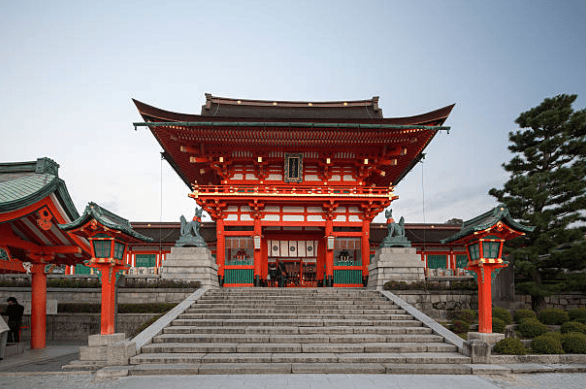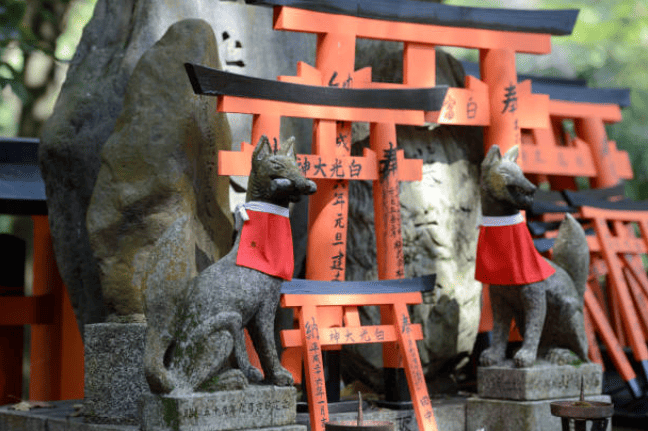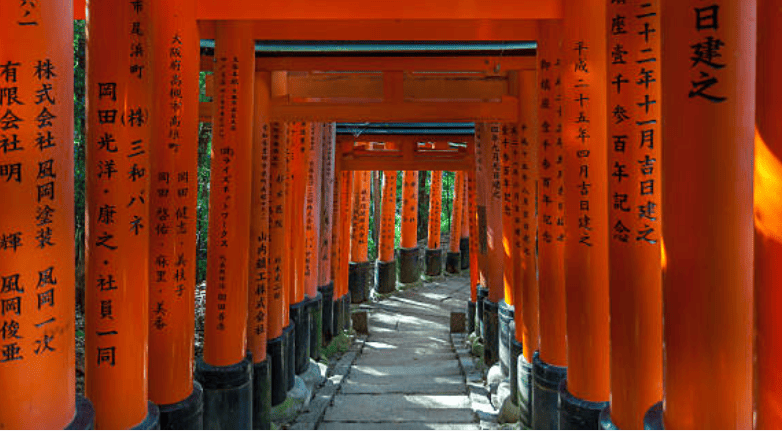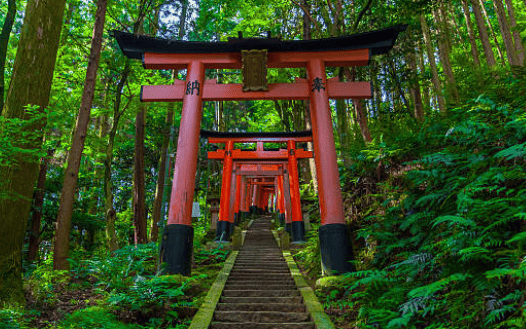Fushimi Inari Taisha is a prominent Shinto shrine located in Fushimi-ku, Kyoto, Japan. It serves as the main shrine among approximately 40,000 Inari shrines that honor the deity Inari. The main sanctuary (honden) lies at the base of Mount Inari, and the shrine’s grounds encompass the mountain, which rises 233 meters.
The shrine venerates Ukanomitama, alongside other deities such as Satahiko no Ōkami, Ōmiyanome no Ōkami, Tanaka no Ōkami, and Shi no Ōkami. Inari is worshipped as the deity of agriculture, making this shrine significant for blessings in crop harvests, success in business, and safety in transportation.
Fushimi Inari Shrine is highly regarded in the Jinmyōchō ranking (a list of shrine names) published in the Engishiki, and is part of the elite 22 shrines in the Nijūnisha list. Under Japan’s old Shinto shrine ranking system, Fushimi Inari was one of the kampeisha (officially funded shrines).
The current main shrine was built in 1499 after the original structure was destroyed during the Ōnin War. It has been designated by the Japanese government as an Important Cultural Property. Since the 17th century, followers of Fushimi Inari have upheld the tradition of building torii gates. There are around 10,000 torii gates along Mount Inari, donated by worshippers. Among them, the famous Senbon Torii (thousand torii) has become a major tourist attraction.
In 711, Hata no Iroku was instructed by the emperor to build a shrine on Mount Inari to enshrine three. According to the Nijūni shaki literature, these deities were Ōmiyame no Mikoto, Ukanomitama no Mikoto, and Sarutahiko no Mikami. A similar account is recorded in the Yamashiro Fudoki, a local historical document. In the Jinmyōchō section of the Engishiki, the shrine is referred to as Inari Jinja Sanza.
In 1871, under the Kindai Shakaku Seido ranking system, Fushimi Inari was designated as a government shrine (kampeisha), and its official name became Inari Jinja or Kampei Taisha Inari Jinja. After World War II in 1946, the shrine became an independent religious organization and was renamed Fushimi Inari Taisha, the name it continues to hold.
Fushimi Inari Shrine is an ideal side trip when visiting Kyoto, as it is located slightly to the south of the city center. It’s highly recommended to add this spot to your itinerary.
To reach Inari from Kyoto Station, wait at platform 8/9 for a local train on the Nara Line. This line can also take you to Nara. You can use an IC card like Pasmo or Suica for this route. Inari is only two stops (5 minutes, ¥150) from Kyoto Station. Upon exiting Inari Station, the shrine is immediately visible across the street. Admission to Inari Shrine is free.

Fushimi Inari Shrine is a Shinto prayer site, and it’s especially popular among Japanese locals. Inari is revered as the rice deity, and it’s common to see small groups of women visiting, often hoping for blessings related to relationships.
At the shrine, you’ll also find many stone fox statues holding keys in their mouths, symbolizing the foxes as messengers of the deity.

The trail behind the shrine, lined with countless torii gates, is particularly famous among tourists for photography. To fully enjoy this, allow 2-3 hours to explore the ascending sacred trail of Mount Inari.

In some sections, the torii are densely placed, creating long corridors, while further up, they become more spaced out, creating a serene, mystical atmosphere. Each torii is typically funded by individual or family donations, with names inscribed on the pillars. Prices for a torii range from ¥400,000 to several million yen, depending on the size.


Can you be more specific about the content of your article? After reading it, I still have some doubts. Hope you can help me.